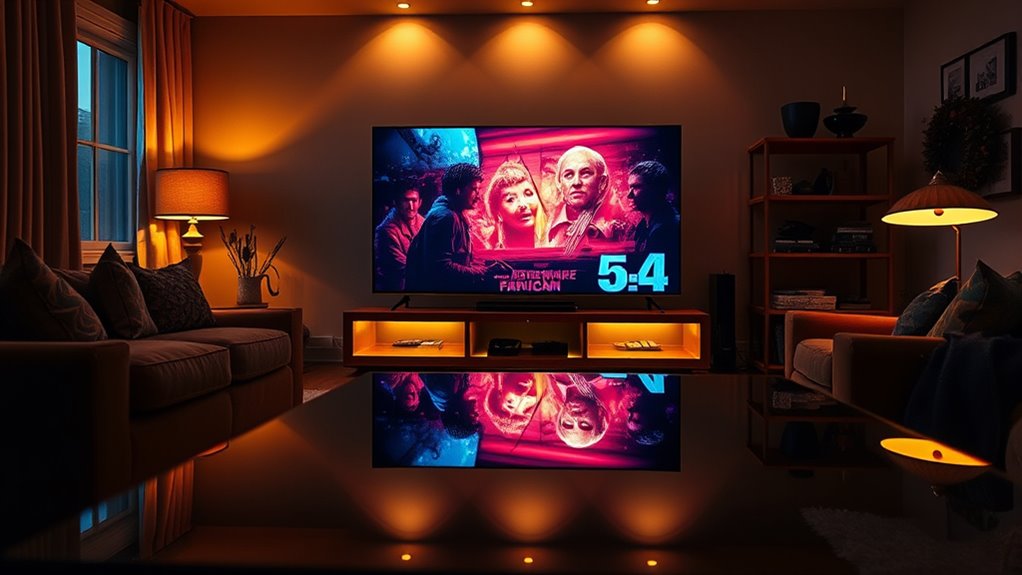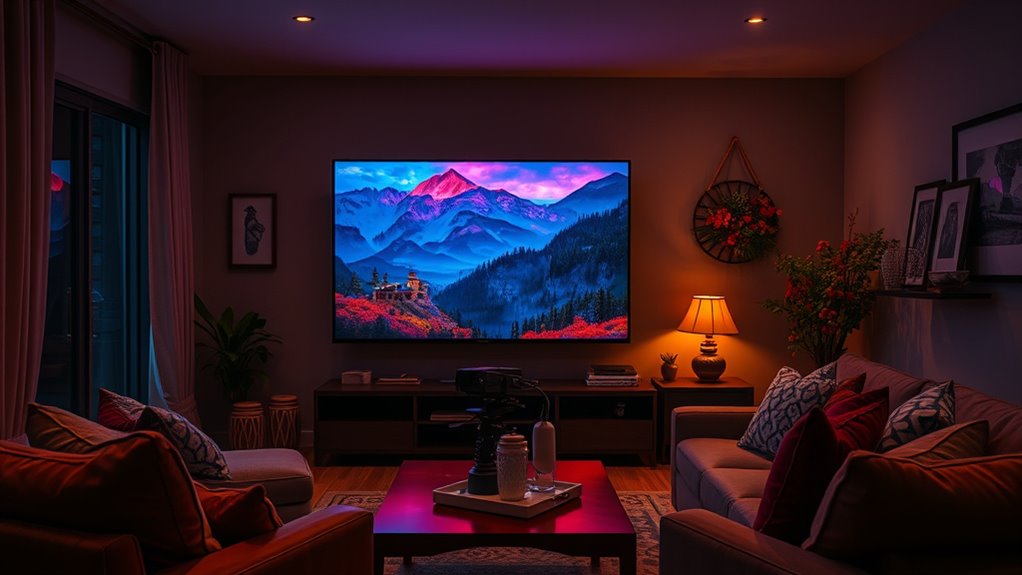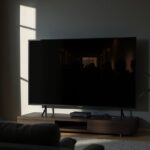HDR, or High Dynamic Range, makes your movie nights more vivid by delivering brighter highlights, richer colors, and deeper contrast. It helps scenes look more lifelike, revealing details in dark shadows and bright highlights that standard displays often miss. This makes your viewing experience more immersive and cinematic. If you want to learn how HDR can transform your home theater, there’s plenty more to discover about its benefits and how to get the best setup.
Key Takeaways
- HDR enhances brightness, contrast, and colors, making movie scenes more vivid and lifelike.
- It reveals details in dark shadows and bright highlights, improving overall picture clarity.
- HDR content offers a more immersive and cinematic viewing experience for movie nights.
- Compatibility with HDR devices and streaming services ensures consistent high-quality visuals.
- Future advancements and growing content libraries make HDR increasingly essential for better movie quality.

High Dynamic Range (HDR) has transformed the way you experience movies at home, making scenes more vivid and lifelike. Instead of flat images with washed-out colors or dull shadows, HDR delivers a richer range of brightness, contrast, and color. When you watch a film with HDR, you notice details in the darkest shadows and brightest highlights that you might have missed before. This isn’t just about making movies look prettier; it’s about creating a more immersive and realistic viewing experience, almost like bringing the theater into your living room.
HDR makes scenes more vivid, detailed, and lifelike, transforming your home movie experience into something truly cinematic.
HDR works by enhancing the contrast between light and dark parts of a scene, allowing bright objects to shine without washing out the darker areas. For example, during a sunset scene, the glowing sun will look intense and radiant, while the shadows cast by nearby objects stay deep and detailed. You’ll see textures and subtle nuances that standard displays often overlook. Colors also pop more vividly, with reds, blues, and greens appearing more natural and true to life. This means that your favorite movies will look more vibrant and true to the director’s original vision, making every scene more engaging and emotionally impactful. Additionally, the development of HDR standards ensures compatibility across different devices, providing a consistent viewing experience.
To truly enjoy HDR, you need compatible devices and content. Not all TVs or monitors support HDR, so you’ll want to check the specifications before investing. Streaming services like Netflix, Disney+, and Amazon Prime now offer a growing library of HDR content, so you can access a wide variety of movies and shows in stunning quality. When you select HDR content, your device adjusts its display settings to maximize the benefits of HDR technology, ensuring you get the best possible picture. Keep in mind that a good HDR experience also depends on your room’s lighting; dim or dark rooms enhance contrast and make HDR visuals more striking. Understanding HDR compatibility can help you make smarter choices when selecting new equipment for your home entertainment setup.
HDR isn’t just a luxury; it’s a significant upgrade that elevates your entire movie-watching experience. It makes scenes more detailed, colors more vibrant, and contrast more dynamic. Whether you’re watching an action-packed blockbuster, a lush nature documentary, or a heartfelt drama, HDR helps you see everything as it was meant to be seen. As technology advances, the availability of HDR-compatible projectors continues to grow, making it easier to enjoy high-quality visuals on a big screen. This development is driven by ongoing innovations in display technology, which further enhance the clarity and realism of HDR content. It’s like liberating a new dimension of visual storytelling right in your living room. As HDR becomes more widespread and accessible, there’s no reason to settle for ordinary picture quality—embrace HDR and transform your movie nights into truly cinematic experiences.
Frequently Asked Questions
Can I Enjoy HDR Content on Any Type of TV?
You can’t enjoy HDR content on just any TV. To experience its full benefits, your TV needs to support HDR formats like HDR10 or Dolby Vision. Check your TV’s specifications before streaming or playing HDR content. If your TV isn’t compatible, images may look dull or washed out. Upgrading to a model that supports HDR guarantees you’ll see vibrant colors and improved contrast, making your movie nights much more immersive.
How Does HDR Affect Gaming Experiences?
You might think HDR only enhances movies, but it also transforms gaming. It boosts contrast, making dark scenes darker and bright scenes pop, so you see more detail and realism. This creates a more immersive experience, especially in visually rich games. With HDR, your games look sharper and more vibrant, giving you a competitive edge and making every moment feel more lifelike. It’s a game-changer for your overall gaming enjoyment.
Is HDR Necessary for All Types of Movies?
You might wonder if HDR is essential for all movies. While HDR enhances visual quality by delivering brighter highlights and richer colors, it’s not necessary for every film. If you prefer standard visuals or watch older movies, HDR isn’t crucial. However, for blockbuster films, animations, or visually stunning content, HDR can considerably improve your viewing experience, making it more vibrant and immersive.
What Is the Difference Between HDR and Dolby Vision?
Did you know Dolby Vision is a premium version of HDR, offering up to 12-bit color depth and even better contrast? While HDR is a broad standard that enhances brightness and color, Dolby Vision adds dynamic metadata for tailored picture adjustments scene by scene. So, if you want the best visual experience, Dolby Vision provides sharper details and richer colors, making your movie nights truly immersive.
Do I Need Special Cables for HDR Content?
You do need special cables for HDR content to guarantee the best quality. Look for HDMI cables labeled as HDMI 2.0 or higher, as they support the higher bandwidth needed for HDR. Avoid older or lower-spec cables, which might cause issues like flickering or reduced picture quality. Using the right cables guarantees you get vibrant colors and sharp images that make your movie nights truly immersive.
Conclusion
So, next time you settle in for a movie night, remember that HDR isn’t just a fancy feature—it’s like giving your eyes a gentle invitation to experience more of the story. By embracing HDR, you subtly open the door to richer colors and deeper contrasts, making every scene feel just a little more real. It’s not about perfection, but about giving yourself the best chance to enjoy the magic unfolding on your screen.
Hello, I’m Art, and I’m excited to be a part of the 1Home Theatre Projector team. As a writer, I’m here to contribute my knowledge and insights to help you achieve the ultimate home cinema experience. I understand that making decisions in the world of home entertainment can be complex, and I’m here to simplify the process for you.
















